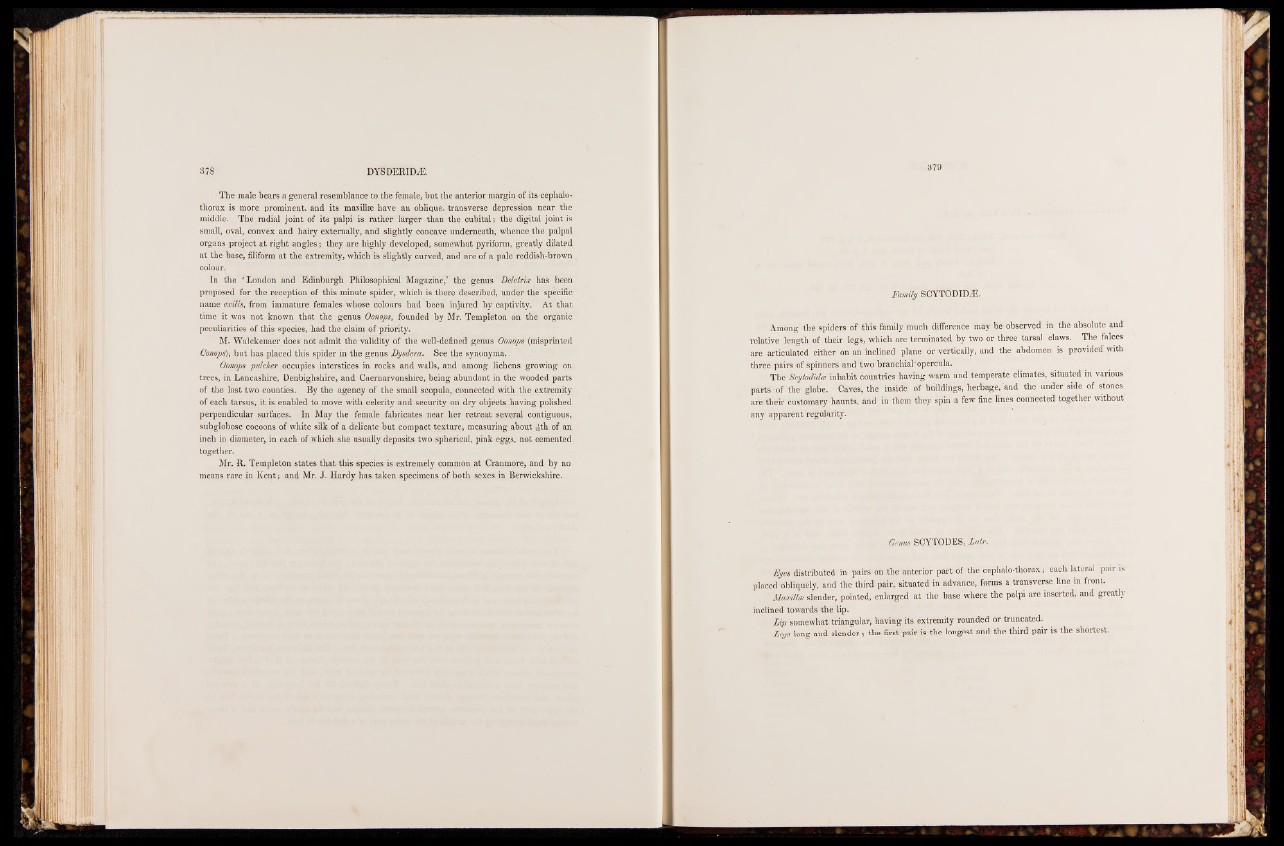
The male bears a general resemblance to the female, but the anterior margin of its céphalothorax
is more prominent, and its maxillæ have an oblique, transverse depression near the
middle. The radial joint of its palpi is rather larger than the cubital; the digital joint is
small, oval, convex and hairy externally, and slightly concave underneath, whence the palpal
organs project at right angles ; they are highly developed, somewhat pyriform, greatly dilated
at the base, filiform at the extremity, which is slightly curved, and are of a pale reddish-brown
colour.
In the ‘ London and Edinburgh Philosophical Magazine/ the genus Deletrix has been
proposed for the reception of this minute spider, which is therç described, under the specific
name exilis, from immature females whose colours had been injured by captivity. At that
time it was not known that the genus Oonops, founded by Mr. Templeton on the organic
peculiarities of this species, had the claim of priority.
M. Walckenaer does not admit the validity of the well-defined genus Oonops (misprinted
ConopS); but has placed this spider in the genus Dysdem. See the synonyma.
Oonops pulcher occupies interstices in rocks and walls, and among lichens growing on
trees, in Lancashire, Denbighshire, and Caernarvonshire, being abundant in the wooded parts
of the last two counties. By the agency of the small scopula, connected with the extremity
of each tarsus, it is enabled to move with celerity and security on dry objects having polished
perpendicular surfaces. In May the female fabricates near her retreat several contiguous,
subglobose cocoons of white silk of a delicate but compact texture, measuring about ^th of an
inch in diameter, in each of which she usually deposits two spherical, pink eggs, not cemented
together.
Mr. R. Templeton states that this species is extremely common at Cranmore, and by no
means rare in Kent ; and Mr. J. Hardy has taken specimens of both sexes in Berwickshire.
Family SCYTODIDÆ.
Among the spiders of this family much difference may be observed in the absolute and
relative length of their legs, which are terminated by two or three tarsal claws. The falces
are articulated either on an inclined plane or vertically, and the abdomen is provided with
three pairs of spinners and two branchial opercula.
The Scytodidce inhabit countries having warm and temperate climates, situated in various
parts of the globe. Caves, the inside of buildings, herbage, and the under side of stones
are their customary haunts, and in them they spin a few fine lines connected together without
any apparent regularity.
Genus SCYTODES, Latr.
Eyes distributed in pairs on the anterior part of the cephalo-thorax ; each lateral pair is
placed obliquely, and the third pair, situated in advancé, forms a transverse line in front.
Maxillæ slender, pointed, enlarged at the base where the palpi are inserted, and greatly
inclined towards the lip.
Lip somewhat triangular, having its extremity rounded or truncated.
Legs long and slender ; the first pair is the longest and the third pair is the shortest.